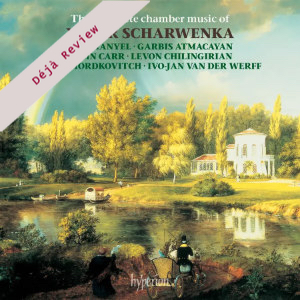
Déjà Review: this review was first published in April 2003 and the recording is still available.
Xaver Scharwenka (1850-1924)
The Complete Chamber Music
Piano Trio No 1 in F-sharp minor, Op 1 (1868)
Violin Sonata in D minor, Op 2 (1868)
Cello Sonata in E minor, Op 46a (1877)
Serenade for violin and piano, Op 70 (1895)
Piano Quartet in F major, Op 37 (1876)
Piano Trio No 2 in A minor, Op 45 (1878)
Seta Tanyel (piano)
Lydia Morkovitch, Levon Chilingirian (violin), Colin Carr, Garbis Atmacayan (cello), Ivo-Jan Van Der Werff (viola)
rec. 1994/95, Forde Abbey, Somerset; Henry Wood Hall, London, UK
Hyperion Dyad CDD22046 [2 CDs: 153]
The delicate and debonair romantic Piano Trio and Violin Sonata have the manners of early Beethoven (Septet, Second Piano Concerto, Second Symphony) and of Mendelssohn – not the last time I shall mention that composer. Scharwenka works happily within this idiom but displays a well-turned skill as a fresh tune-smith who speaks of grace, playfulness and beauty. The First Trio has a gem of an andantino. Lydia Mordkovitch (on holiday from Chandos) with her plungingly eloquent febrile tone is a superb foil to Seta Tanyel’s lively imagination and Florestan romance. Mordkovitch’s delicate moonlight skills can also be heard in the Op. 70 Serenade. You should not expect scorching passion in the two early works (Opp. 1 and 2); Scharwenka has a much lighter touch though one that is far from inconsequential.
Scharwenka’s Cello Sonata is a deeper work that probes more demandingly and gazes at times into the early style of Rachmaninov. Colin Carr’s singing resinous tone is memorable. For all that Scharwenka was a keyboard lion among Europe’s pianistic pride he wrote generously and unselfishly for stringed instruments.
The second disc includes two substantial and ambitious works – a piano quartet and a piano trio – each approaching forty minutes duration. The Piano Quartet has a magically trilling first movement, flowingly Mendelssohnian and as striking as the andantino of the First Piano Trio. A hesitantly thoughtful adagio is followed by an allegro vivace which frames a delightfully rocking ‘dream dance’ with pushy and alert scherzo episodes. I was not quite so sure about the busy turbulent romance of the finale. There is quite a bit of Schumann in the piano writing here.
The Second Piano Trio is deeply immersed in the nineteenth century romantic melos and its roots are struck deep into Schumann territory. While there are no signs of originality in the language the flow and concentration is irresistible and well sustained even across such a substantial structure. While the second movement has the salon quality of a ‘maiden’s prayer’ and the scherzo third infuses Mendelssohnian fleet-foot pacing into another sweet-toned lullaby picked out with the pizzicato equivalent of bone china.
Seta Tanyel is the strong and sensitive constant throughout all six pieces. There is little difference between the two recording venues. The second disc is distinguished by intakes of breath (not many) that I do not recall at all from the first disc. I did not find that a problem.
The notes and performing materials are all courtesy of Martin Eastick. It is too much to hope that Scharwenka’s opera Mataswintha would be recorded but given Hyperion’s superb disc of the two Bortkiewicz symphonies I wonder if they are thinking of coupling the Scharwenka symphony perhaps with one of Benjamin Godard’s exotics. Seta Tanyel recorded the Scharwenka Second and Third Piano Concertos for Collins. Is there any chance of Hyperion acquiring the rights and reissuing this as part of the ever-expanding Romantic Piano Concerto series? While we are on the subject of neglected Slav piano concertos I rather hope that Hyperion will see the commercial symmetry of recording the second and third Bortkiewicz piano concertos as a follow-on to their recording of the two symphonies and the First Piano Concerto. Bortkiewicz was much more than the inconsequentiual note-spinner reputation that has been pinned to him.
Back to Scharwenka. This is all highly attractive romantic music caught in the web of lay-lines between Schumann and early Fauré. Prettiness and empty display are absent and Scharwenka shows himself to be a serious musician well able to sustain an equable instrumental balance without undue prominence to the heroic piano.
Rob Barnett
Help us financially by purchasing from



















